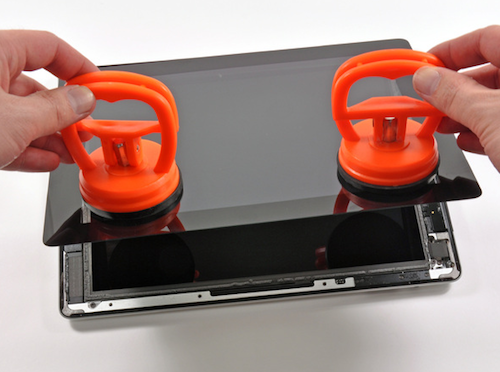The New iPad Spills Its Guts A Day Early
We're still a day ahead of the official domestic launch of Apple's (NAS: AAPL) latest and greatest iPad. That hasn't stopped gadget repair shop iFixit from landing an early third-generation unit from a midnight launch in Australia (where it's Friday already), and promptly tearing it to pieces.
iFixit's unit is a 16 GB model with 4G LTE, but unfortunately the device isn't compatible with Australian 4G LTE networks, so will be relegated to 3G data speeds within the country. Australia isn't the only geography on the iPad's LTE no-fly list, as many European countries also won't make the cut. This is because the new iPad is compatible with only the 700 MHz and 2100 MHz frequency bands, while most other countries use different bands.
On with the teardown
In any event, the teardown will give valuable insight into what component suppliers Apple is tapping, and there are plenty of reasons you should be looking at mobile component plays now, as the tablet semiconductor market is set to explode over the next couple of years.

Source: iFixit.
The first thing to look at is the fancy 2048 x 1536 Retina Display that early reviewers are drooling over. I've already pegged this panel as the most-likely culprit behind the iPad shortages that Apple is seeing in the face of surging demand. There's some debate over how many suppliers are making these displays for Cupertino, with three potential candidates in the running: Samsung, Sharp, and LG Display.
Samsung may be the one and only, but Reuters believes LG Display may also have made the cut. iFixit's unit appears to have Sammy's signature on it, but we'll need a larger sample size before jumping to any conclusions.
Here are some more nitty-gritty details:
Broadcom held down its usual fort with the Wi-Fi and Bluetooth chips, while the new iPad's Bluetooth capabilities have been upgraded to a more power-efficient 4.0 version. It also supplied an I/O controller and another microprocessor.
Apple's custom-designed ARM Holdings-based dual-core A5X with a quad-core GPU has already been run through some early tests, with the CPU clocked at 1 GHz (just like the previous A5), while its RAM was upgraded from 512 MB to a healthy 1 GB (sourced from the now-bankrupt Elpida). As expected, Samsung still also fabricates this chip; meanwhile, rumors continue to circulate that Apple wants to take its A6 business to Taiwan Semiconductor Manufacturing.
TriQuint (NAS: TQNT) , Skyworks (NAS: SWKS) , and Avago all supply power-amplifier modules, just like they did in the iPhone 4S.
Qualcomm (NAS: QCOM) provides a multi-band/mode RF transceiver for LTE frequency bands and power management integrated circuit. As expected, the new iPad also carries one of Qualcomm's world-mode baseband modems that can handle both 3G and 4G. It's a similar flavor to the one I had previously mentioned might make it, but I was jumping the gun a little there.
Don't expect iFixit to be able to positively identify the 5-megapixel image sensor as either OmniVision Technologies (NAS: OVTI) or Sony. Sony sources the 8-megapixel shooter in the iPhone 4S, but we'll need to wait for Chipworks to run through the arduous identification process on this piece. Baird thinks OmniVision scored this one.
Apple has been known to dual-source NAND flash from Toshiba and Samsung (it also does this for the MacBook Air's custom flash storage). This particular unit carries a 16 GB flash chip from Toshiba.
Texas Instruments has a couple of slots again, and previously has provided the touchscreen microcontroller for iDevices over rivals like Atmel or Cypress Semiconductor, although Cypress did recently win a spot in the sixth-generation iPod nano and powers many a MacBook trackpad (including those on the popular MacBook Airs).
These are but the more-notable highlights and is hardly an inclusive list of all that is inside the new iPad. There weren't really any major surprises lurking underneath that high-resolution display, and Cupertino didn't really deviate from its standard suppliers in any meaningful way.
One of the more-notable components that most watchers are keeping an eye on, however, is whether or not OmniVision was able to reclaim the cushy camera spot, but unfortunately we'll have to wait a bit longer for that sensor's origins.
Another way to play
While Apple is a great way to play the rise of mobile computing, it's hardly the only one. The exploding component market for mobile devices is one of the most promising growth opportunities for investors.
To make it a little easier to capitalize on this opportunity, The Motley Fool has just released a new special free report that names "3 Hidden Winners of the iPhone, iPad, and Android Revolution," including two companies named in this article and one additional play to consider. Let us do the dirty work for you by sorting through device teardowns and tech specs; all you have to do is get a copy of this free report. Free and easy -- what more could you ask for?
At the time thisarticle was published Fool contributorEvan Niuhas sold bullish put spreads on QUALCOMM and owns shares of ARM Holdings, OmniVision Technologies, Cypress Semiconductor, and Apple, but he holds no other position in any company mentioned.Click hereto see his holdings and a short bio. The Motley Fool owns shares of TriQuint Semiconductor, QUALCOMM, and Apple.Motley Fool newsletter serviceshave recommended buying shares of Cypress Semiconductor and Apple; and creating a bull call spread position in Apple. Try any of our Foolish newsletter servicesfree for 30 days. We Fools may not all hold the same opinions, but we all believe thatconsidering a diverse range of insightsmakes us better investors. The Motley Fool has adisclosure policy.
Copyright © 1995 - 2012 The Motley Fool, LLC. All rights reserved. The Motley Fool has a disclosure policy.

